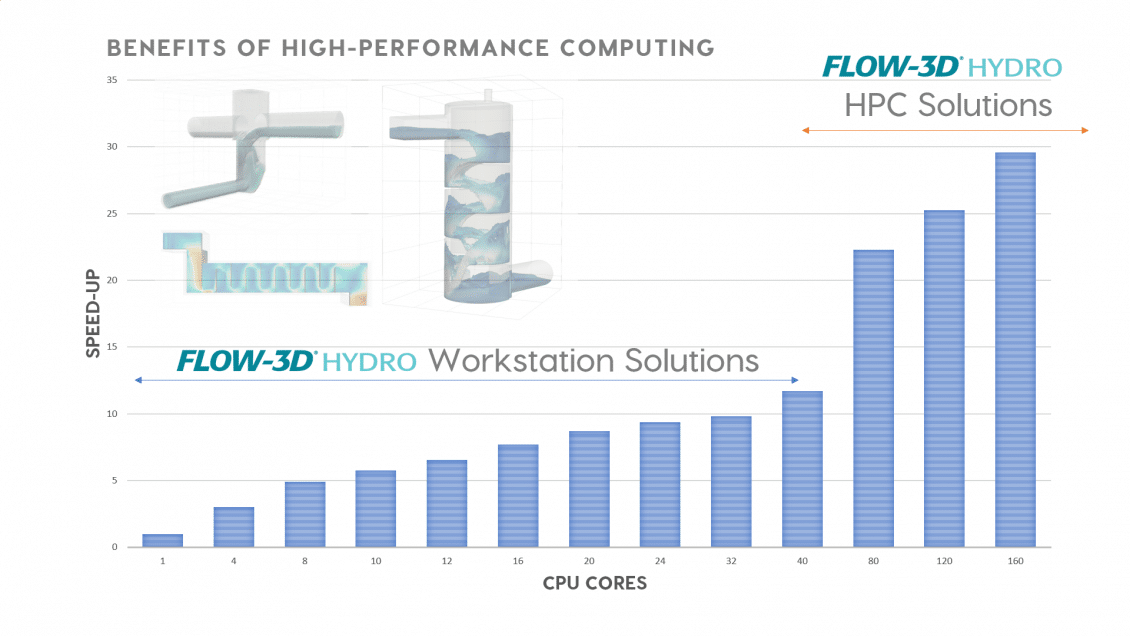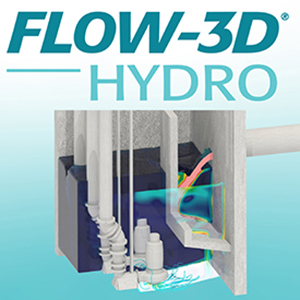FLOW-3D HYDRO’s new streamlined user interface focuses on the needs of the water community. A ‘What You See Is What You Need’ (WYSIWYN) approach to model setup, application-specific workspace templates, and a new library of simulation examples promote unparalleled workflow efficiency, while access to high performance computing options and continued development of advanced solver capabilities deliver a state-of-the-art CFD modeling solution for water infrastructure & environmental engineering applications. FLOW-3D HYDRO continues to uphold Flow Science’s core commitment to first class technical support and customer service.
Streamlined GUI for W&E Practitioners
FLOW-3D HYDRO’s streamlined user interface features workflows designed for civil & environmental applications, providing effective, accurate and error-free modeling.
User success is achieved through:
- Immediate access to relevant modeling features and parameter selection options
- Removal of unnecessary information, allowing for superior modeling clarity and modeling outcomes
- A faster, more sequential workflow with enhanced visibility of important settings, meaning fewer places to make mistakes
- Convenient defaults that save you time and remove repetitive entries
- Help and guidance when you need it
- A new extended examples library covers a wide range of model problems from simple to complex example use cases
- Video tutorials and templates provide additional immediate guidance for the most challenging modeling needs
Simulation Templates
Save time, avoid mistakes, and run consistent models with FLOW-3D HYDRO’s Workspace Templates. Workspace Templates pre-load fluid properties, physical models, numerical settings and simulation outputs for common applications.
Workspace Templates are available for seven classes of models:
- Free surface – TruVOF (default)
- Air entrainment
- Thermal plumes
- Sediment transport
- Shallow water
- Free surface – 2 fluid VOF
- No free surface
Pre-loaded Example Simulations
FLOW-3D HYDRO’s library of over forty pre-loaded water-focused example simulations provide a great starting point for modeling your application. Pre-loaded example simulations give modelers a detailed starting point for most applications as well as a roadmap of model setups and best practices.
Video Tutorials
Video tutorials provide an excellent route for new users to quickly learn how to model a wide variety of applications. FLOW-3D HYDRO video tutorials feature:
- A-Z step-by-step recording for a wide range of application and physics
- “How-to” information
- Tips for best practices
- CAD/GIS data, simulation files and post-processing files
Advanced Solver Developments
Tailings Model
The new tailings model provides advanced capabilities for simulating tailings runout due to tailings dam failure. A bi-modal viscosity model representing fine and coarse particle compositions along with a multi-layer approach to tailings definition allows for modeling of tailings dams constructed by any method. Flexible meshing, including shallow water, 3D, and hybrid 3D/shallow water meshing allows the complexity of multi-layered tailings to be accurately modeled while providing fast solutions in shallow regions. A two-layer Herschel-Bulkley viscosity model is available for shallow water meshes for accurate representation of viscous boundary layers.
Model Highlights
- Bi-modal viscosity model for fine and coarse particle tailings compositions
- Tailings transport including settling, packing, and turbulent diffusion of particle species
- Two-layer Herschel-Bulkley viscosity model for shallow water meshes
- Flexible meshing approaches including 3D, shallow water, and 3D/shallow water hybrid meshes
- Multi-layer, variable composition tailings for general definition of tailings dam construction
Shallow Water
FLOW-3D HYDRO’s shallow water modeling capabilities employ unique hybrid meshing that allow 3D meshes to be combined with shallow water meshes for exceptional modeling versatility. Numerical improvements to the pressure solver have resulted in more stable, faster simulations. The bottom shear stress calculations in hybrid meshes have been greatly improved, further increasing their accuracy. New methods of applying roughness to topography include Strickler, Chezy, Nikuradse, Colebrook-White, Haaland, and Ramette equations.
Two-Fluid VOF Model
A two-fluid model, with or without a sharp interface, compressible or incompressible, has always been available in FLOW-3D along with the one-fluid free-surface model. In fact, the sharp interface treatment shares the TruVOF technology with the free surface model and is unique in commercial CFD software. Recent developments included two-field temperature and interface slip models. The model has been successfully applied to oil/water, liquid/vapor, water/air and other two-phase systems.
FLOW-3D HYDRO sees two important advances in the accuracy and stability of the two-fluid solution. An enhanced coupling of the momentum and mass conservation equations improves momentum conservation at the interface, especially for liquid/gas flows. Expanded approximations of the limited compressibility terms in the continuity equation result in a faster and more stable two-fluid pressure solver.
Both developments are timely for the FLOW-3D HYDRO release, as air often plays a crucial role in hydraulic applications, for example, in tunnels and dropshaft designs. Limited compressibility is typically used for water and air in such cases due to typically low Mach numbers.
High Performance Computing and the CLOUD

While much work can be done with regular workstations or even laptops, large simulations as well as high definition simulations benefit immensely from tapping into more CPU cores. FLOW-3D CLOUD and High Performance Computing deliver just that: faster runtimes and more choices to run larger, more accurate models. To learn more about how FLOW-3D HYDRO can be installed on your in-house HPC cluster, flexible options for deploying on FLOW-3D CLOUD or our HPC Services, please contact us. The net result? A simulation that might take four to five days to run on an 8 core workstation will often be completed overnight on a 160 cores HPC solution, whether in-house on your local cluster, or running on as few as four nodes on FLOW-3D CLOUD.

